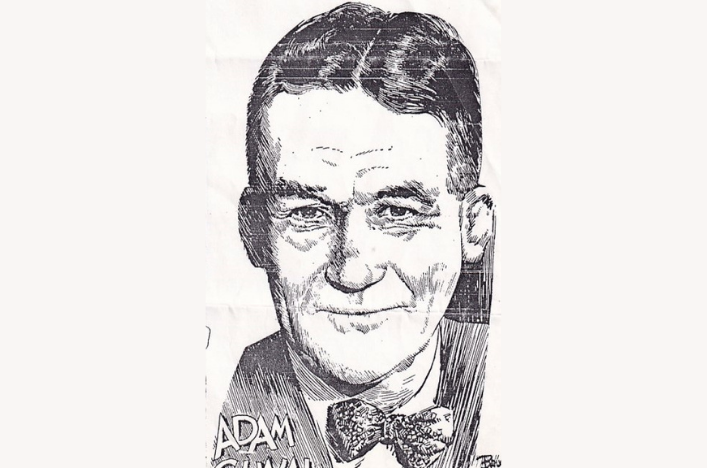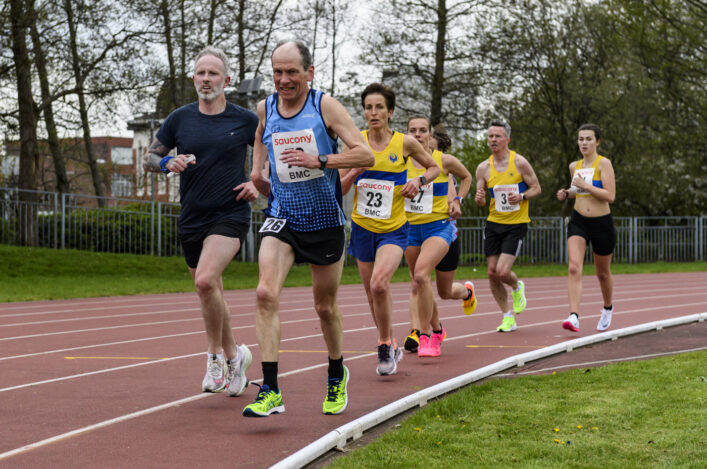The man from Golspie – Adam Beattie Gunn

Scotland’s First Olympic Track & Field Medallist
Born in Golspie on 24 December 1872, Adam Beattie Gunn emigrated to the United States in 1893, getting a job with the General Electric Company in Buffalo, New York.
He represented the United States at the 1904 Olympic Games at St Louis. Adam was 2nd in the All-around at the 1904 Olympic Games at St Louis. The medallists were: 1 Tom Kiely (Ireland) 6,036 points; 2 Adam Gunn (USA) 5,907 points; 3 Truxton Hare (USA) 5,813 points.
In winning the silver medal, Adam became the first Scottish man to win a medal in the Olympic Games Track & Field competition.
The story of Adam’s life was told by the journalist Joe Cummiskey of the Buffalo Times. The following article appeared in that newspaper on 1 January 1930. – Arnold Black
+++
A raw-boned Scottish laddie laboured up the slope of Mt. Ben Vraggie in far-off Scotland in 1886. And once atop the rock-strewn summit he chiselled his name in the base of a monument which there stood erected to the Fourth Duke of Sutherland.
And if your wandering footsteps ever carry you into that part of the land of the Plaid you can still read the name, smoothed out now by the winds of time: “Adam Beattie Gunn”.
Looking down into the rolling country beneath you, you see smoke curling lazily from the house-tops of the quaint town of Golspie, noted, if for nothing else, as the stronghold of the family Gunn.
’Twas down in that green-clad valley that young Adam bowled on the green and tested his strength with other village lads, dreaming the while of the day he might sally forth into the world in search of fame and fortune – ever a fleeting thing.
For 21 years Adam grew up with his family, and a large family it was. The second son of a family of 12 was Adam. Strong of limb, quick of foot, a clear-eyed lad was he.
Finally there came a day when young Adam, with a lump in his throat belying the smile on his face, set off down the dusty road to Glasgow, there to set sail for these United States of ours.
It isn’t hard to pick up the threads of the career of the second son of the Gunn family now. Young Adam got to Buffalo finally. In 1893 he got a job with the General Electric company.
And word was spread near and far of his athletic prowess. He could run, jump, toss weights, wrestle and box. He weighed 154 pounds and every inch of him was fibery muscle which bent like a willow but never broke.
In four years’ time, Adam Gunn’s name was synonymous with the all-around athletic event which consists of 10 of the most rigorous programs in sport.
But at that time Buffalo had a sort of a black eye, so to speak, in the amateur athletic world. Ringers, was the reason, they tell me.
So it wasn’t until the Pan-American year that Adam came into his own. That was 1901. The best athletes from all over the country were here. Among them was a young gent named Bob Edgren, the now-famous sports cartoonist.
Adam won in the all-around in a breeze. Defeating great, big husky guys whom “it gave me a pleasure to beat”, says Adam today.
In case you don’t know about this all-around test which is now the decathlon, here’s the order of the events you competed in: 100-yard dash; 16-pound shot put; running high-jump; half-mile heel and toe walk; 16-pound hammer throw; pole vault; 120 yards high hurdles; 56-pound shot put; long jump, and the mile run.
They held the Olympic try-outs in St Louis in 1904 and Adam Gunn was entered in the all-around. He took second to Tipperary Tom Kiely. He lost by the well-known nose.
They arranged a match in those days between Adam and Matt McGrath, the weight throwing gent, here in Buffalo. But Matt, a trifle high-hat because of his reputation, balked at the 16-pound throw – he insisted on a 24-pound hammer.
They roped off Lafayette Field that day in 1906. A big crowd gathered to watch what was to become a battle between Scotland and Ireland. When McGrath tossed they marked the spot by placing a tiny Irish flag in the hole.
When Adam Gunn wound up his comparatively slight form and heaved the hammer, they placed the flag of Scotland to mark the spot where fell his missile. And it was three feet farther than Matt McGrath’s. ’Twas a great day for the Scots.
Adam has a pair of medals in his possession which are as rare as peaceful elections in Mexico. One is emerald-studded, the other diamond. Both were won in the all-around. One for the Pan-American performance, the other in the Greater New York Irish Athletic club games at Celtic Field, New York, July 4, 1902.
Adam is nearing his 60th birthday. He was born just two hours before Christmas in 1872. And he doesn’t look a day over 40. He was in active competition at the age of 49.
His job today is titled: “Distribution Superintendent of the Buffalo area of the Niagara Hudson Power Corporation”. He has about 500 men under him, they tell me.
Hale and hearty, bubbling with good humour and a burr on his tongue which makes you listen twice to catch what he’s saying, Adam will never tear himself from the land of his birth.
“Ye know”, sez he, “I get hame every now and then. I’ve been back four or five times since I first left. And everytime I do I tak’ ma medals wi’ me and give them to my mither to show to the folks ’quiring how I’m getting along.”
I got ready to leave him.
“And say if you don’t mind I’d like a couple of those stories to send her. She’d be tickled to get them. I may be 60 to you, but ye ken how mithers are. I’ll just send one to ma brither down in Kimberly, South Africa, too. He’s postmaster there.”
So I took my leave of Adam Beattie Gunn, as Scottish as the heather and as loyal. His father was an athlete, too. John Forsythe Gunn was his name. And Adam – well, he’s a son of a Gunn, no matter how you take it.
+++
Five years later, Adam returned to Scotland to visit his widowed mother for her 88th birthday. Sadly, he took ill on the sea passage and was taken to hospital when he landed in Greenock. He passed away from a cerebral embolism at the Larkfield Hospital in Greenock on 17 August 1935, aged 62.
He remains a celebrated figure in Buffalo, and was inducted into the Greater Buffalo Sports Hall of Fame in 2019.
The story of Adam and Scotland’s other Olympic athletes can be read in John W Keddie’s recent publication: Scotland’s Track and Field Olympians, 1896-1980.
#OTD in 1902 for the second time, Buffalonian Adam Beattie Gunn wins the national all-around (decathlon) championship of the A.A.U. held at Celtic Park, Long Island. pic.twitter.com/eCL91MNSim
— ThisDateInBuffaloSportsHistory (@BuffSportsHstry) July 4, 2019
Latest Articles
Weekend Previews

Latest Facebook update
2 hours ago
Hundreds set for Highland Fling Race - with Scottish medals up for grabs - Scottish Athletics
www.scottishathletics.org.uk
Sophie Mullins in ACP action in Perth in 2019 By Adrian Stott This Saturday sees the 16th edition of the Highland Fling Race, with just over 700 runnersShare on Facebook Share on Twitter Share on Linked In Share by Email